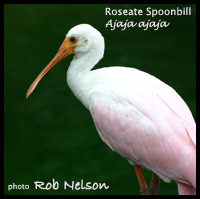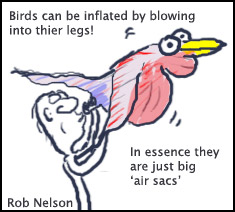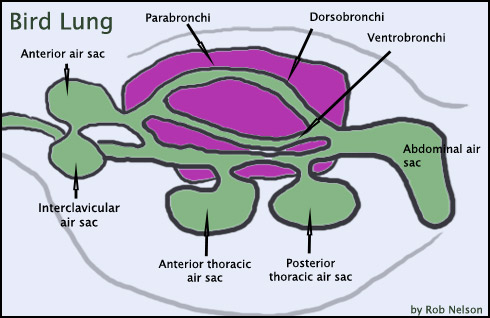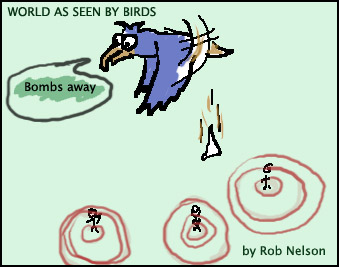 Environmental
Physiology.
Environmental
Physiology. Birds have unique metabolic rates and have thus been used as model systems for the study of metabolism. In essence, they are creatures that are living life in the ‘fast lane’ - more on that later.
If you look at the average body temperature of vertebrates you’ll find that birds have the highest average body temperature of all. They’re significantly higher than mammals and are actually right on the cusp of protein denaturation. As mammals we can increase our body temperature when we have a cold. Birds can’t do that. To understand why we must first understand a bird's metabolism.
What is Metabolism? It is defined as the chemical activities that provide energy for power, endurance, repair, storage, and reproduction. It's usually measured in kcal/kg/hr or as cc O2/g/hr. There are three types of metabolism that we measure in birds:
- Basal – metabolism performed when not digesting food.
- Existence – when an animal has to thermo-regulate or
digest a meal. However, this metabolism occurs when it’s not locomoting or exerting any pressure
besides standing on the ground.
- Productive – metabolism when an animal is walking, flying, or getting ready to produce sperm/egg.
Larger birds produce more energy per day than smaller birds. For instance, passerine bird metabolism is greater than non passerine birds for a given body size. Most passerine birds have a body temperature from 40-42 deg.
Birds have unique problems related to their flying habits. Here is a list of some of the main questions that are important to ask about bird metabolism.
- How is oxygen obtained in sufficient amounts?
- How is overheating prevented?
- How is heat loss prevented or heat conserved?
- How is sufficient food obtained and processed?
- How is water and electrolyte balance maintained?
 How do birds breathe?
How do birds breathe?
This is a great question to examine because they breath very differently from
mammals. In fact, their lungs are only a small part of their breathing
apparatus. They also contain air sacs that extend anteriorly and posteriorly
from the lungs. These sacs can be so large that they extend into the large
bones in the legs. If you were dissecting a bird you could cut a leg in
half and blow up the bird via these sacs. More or less, birds are just
large feathered balloons.
While mammals have a sort of ‘cul de sac’ type of lung (that is ‘in and out’), bird’s lungs are more like radiators where there is a one-way flow through the lung. Movement of air through the lungs is as follows: Glottis – trachea – syrinx – bronchus to each lung – mesobranchus, dorsobronchus, ventrobronchus, parabronchus.

To move air through the lungs one needs to have two inhales and two exhales. It’s a very interesting system. The first part of the lungs is the parabronchi. Within the parabronchi tubes are the small air capillaries that have cross-current gas exchange and thus provide oxygen.
 Birds have two sets of air sacs. One set has connections near the front of the lungs. The other set has connections to the back of the lungs. These are the anterior (cranial) air sacs, and the posterior (caudal) air sacs respectively.
Birds have two sets of air sacs. One set has connections near the front of the lungs. The other set has connections to the back of the lungs. These are the anterior (cranial) air sacs, and the posterior (caudal) air sacs respectively.
On inhalation both sets of sacs expand at the same time. This causes a reduction in pressure and air enters the bird's trachea to fill the sacs. Half of the air enters the posterior air sacs directly. The other half enters the lungs at their posterior end and passes through the lungs to fill
the anterior air sacs.
The posterior air sacs become filled with fresh air while the anterior sacs become filled with breathed air.
On exhalation both sets of sacs contract at the same time. Breathed air passes directly out of the anterior sacs and out via the trachea. Fresh air is blown from the posterior sacs into the posterior end of the lungs and then passes through the lungs and out via the trachea.
One inhale and one exhale constitute a complete cycle. Fresh air passes through the lungs, in the same direction, when inhaling and exhaling.
Note that there is a small residual volume of air left in the lungs after the exhalation. It would require a second cycle before this air was expelled from the bird. This is the genesis of the 2 cycle idea.
Its only ~10% of the total lung + air sacs volume and some of it may persist in the anterior sacs even after the next cycle.
To read more about bird respiration visit these sites.
- This website has papers on aerodynamic valving, some have further descriptions of bird respiration.
- This is also a great respiratory site: It mentions the two cycle idea but it also gives a proper description of the respiratory cycle.
Some birds actually have a coupling between flight and inhalation and exhalation. For instance, when the sternum is pushed up through through the flying motion, a bird can exhale. During the rest of a wing cycle when the sternum comes down a bird can inhale.
When compared to the breathing in mammals, birds actually take fewer breaths. They also have hemoglobin that can hold more oxygen than mammals (due partly to a higher surface area resulting from the smaller size of the molecules).
Circulatory system of birds.
To transport the blood around the body of a bird, the bird must have an
efficient heart. In fact, bird hearts are almost twice the size of comparable
mammals. This is just another example of how birds are extreme high-powered
animals. Finally, if you look at migratory and higher latitude birds they have
larger hearts than lower latitude birds.
Heat regulation: Birds actually have great ways of regulating the heat in and out of their bodies. Lets look at the three ways heat can be transferred:
- Conduction: Heat transferred between two bodies that
are touching each other.
- Convection: Movement of gases between solids.
- Radiation: Releasing energy like a light-bulb. Net radiation from the sun to any body on earth is an example of radiation.
For birds, heat is regulated in a few different ways. When birds are cool they shiver or fluff their feathers (to hold in heat), and if they are hot they have to use evaporative cooling (birds such as desert vultures actually poop on their legs to use this phenomenon). Birds such as penguins have the ability to use counter-current circulation in their legs to keep up their core body temperature. Some birds, will crowd together to stay warm. On a large scale, birds in colder environments are usually larger than others of the same species in colder environments (Bergman’s Rule). At night birds will reduce their body temperature and go into a state of torpor to decrease energy expenditure.
Kidneys
Ever been on a long camping trip and run out of water? You pee out a lot
of it but you’re not supposed to drink it. Our urine requires water
to dissolve in and thus reduces our water supply every time we pee. Birds
are different. They actually produce uric acid as opposed to urea. Their
pee is like a paste and it is usually white. The fecal mater is brown. Thus
when you think a bird has ‘pooped’ on you, its probably more likely it peed on you (its the uric
acid)! In fact this system is so well adapted that they can concentrate
their excrement to over 3000 times that of their blood!
Salt glands:
Another harsh environmental factor that birds must contend with are those
of the saltwater environment. Saltwater birds actually have salt glands
located close to their eyes that allow them to excrete salt. Actual secretion
occurs through what looks like tears, but in reality is a salty drop of
water!
By Rob Nelson


